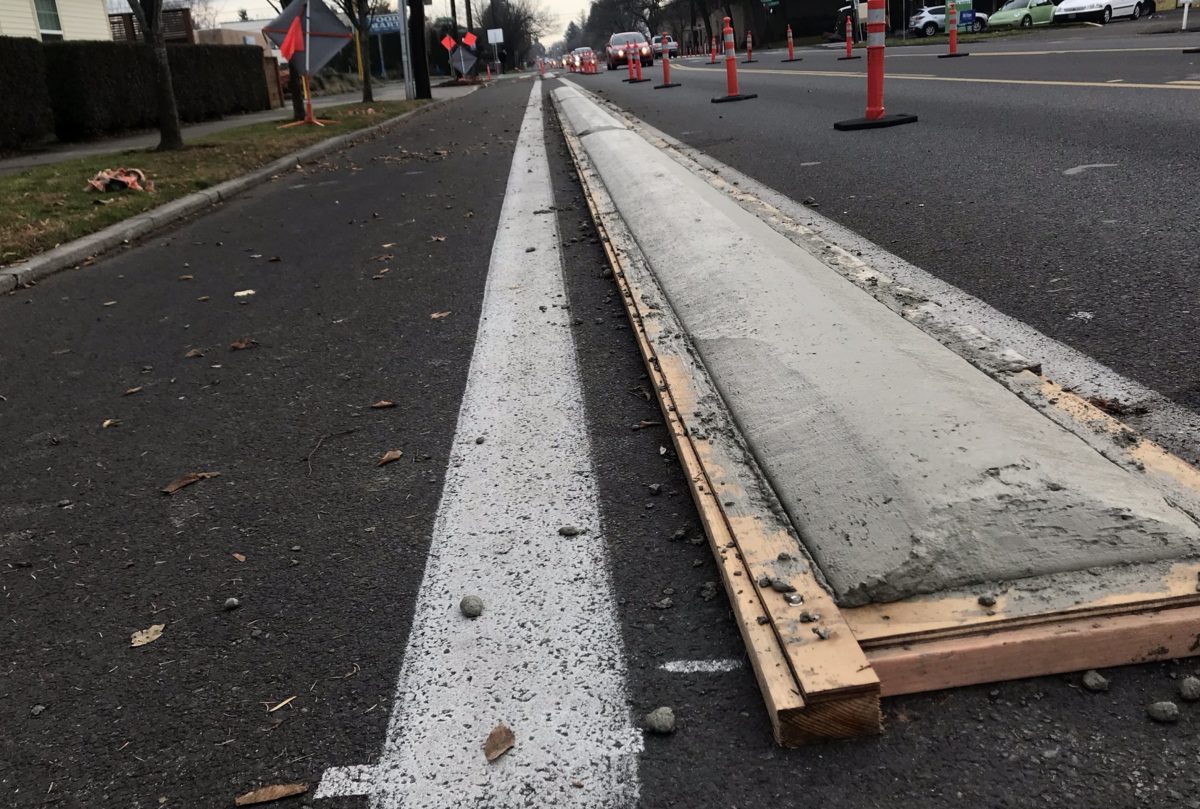
(Photos © J. Maus/BikePortland)
The day has finally come!
Nearly two years after the Portland Bureau of Transportation announced plans for protected bike lanes on North Rosa Parks Way, crews are installing concrete curbs to separate bicycle and car users.
Initially planned with delineator wands, PBOT heard from local residents that the skinny, plastic bollards weren’t aesthetically pleasing enough to grace the neighborhood’s most important street. Plastic wands were installed (and will remain) at several key conflict points, but the main mode of protection moving forward will be a shaped concrete curb that stands about five inches tall.
The new curbs are being installed intermittently between NE Martin Luther King Jr. Blvd and N Willamette Blvd.
PBOT Project Manager Scott Cohen told us in August 2018 that, “I think it’s going to look great. These [curbs] will look better and will protect the bike lane more than plastic wands.”
Advertisement
This is the first time PBOT has installed concrete curb protection for a bike lane in a Portland neighborhood. The only other place this design is currently used is in an industrial section of Lombard north of downtown St. Johns.
To get an idea of what the finished product on Rosa Parks Way will look like, below is what Lombard looks like:
According to PBOT, the curbs will be installed in sections with gaps to allow access for turning lanes, driveways, and the few parking spots outside a coffee shop near North Interstate Ave. Also don’t expect to see this protective measure in use over I-5 because the Oregon Department of Transportation controls that section of Rosa Parks and they don’t approve of them.
I’m eager to see how these curbs impact the use of the street. If they work here, I’m sure PBOT will be more likely to use them in other projects (especially if you advocate for them!). In addition to creating a safer, more respectable cycling space, I suspect they’ll act as medians that calm traffic on the street even further than the recent restriping and other updates PBOT has made.
If you ride on Rosa Parks, please let us know what you think. Better yet, drop PBOT’s Scott Cohen a line and tell him – Scott.Cohen@portlandoregon.gov.
— Jonathan Maus: (503) 706-8804, @jonathan_maus on Twitter and jonathan@bikeportland.org
— Get our headlines delivered to your inbox.
— Support this independent community media outlet with a one-time contribution or monthly subscription.



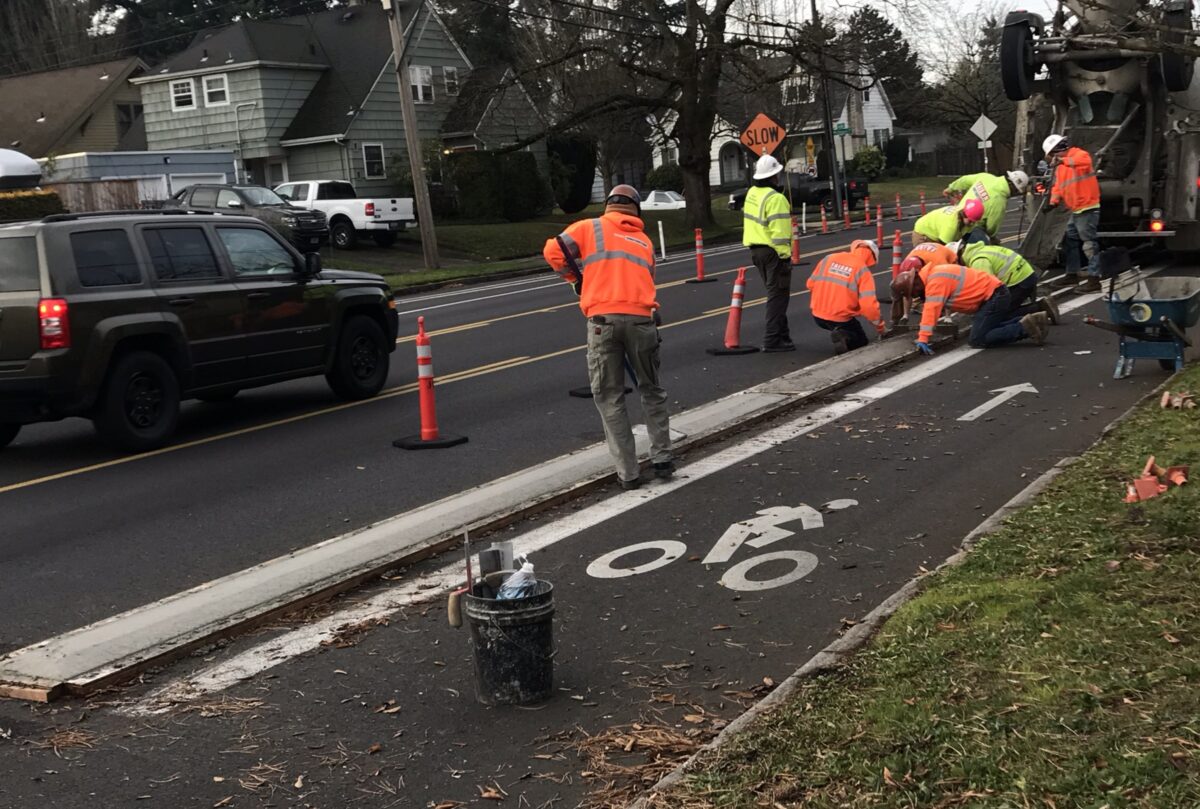
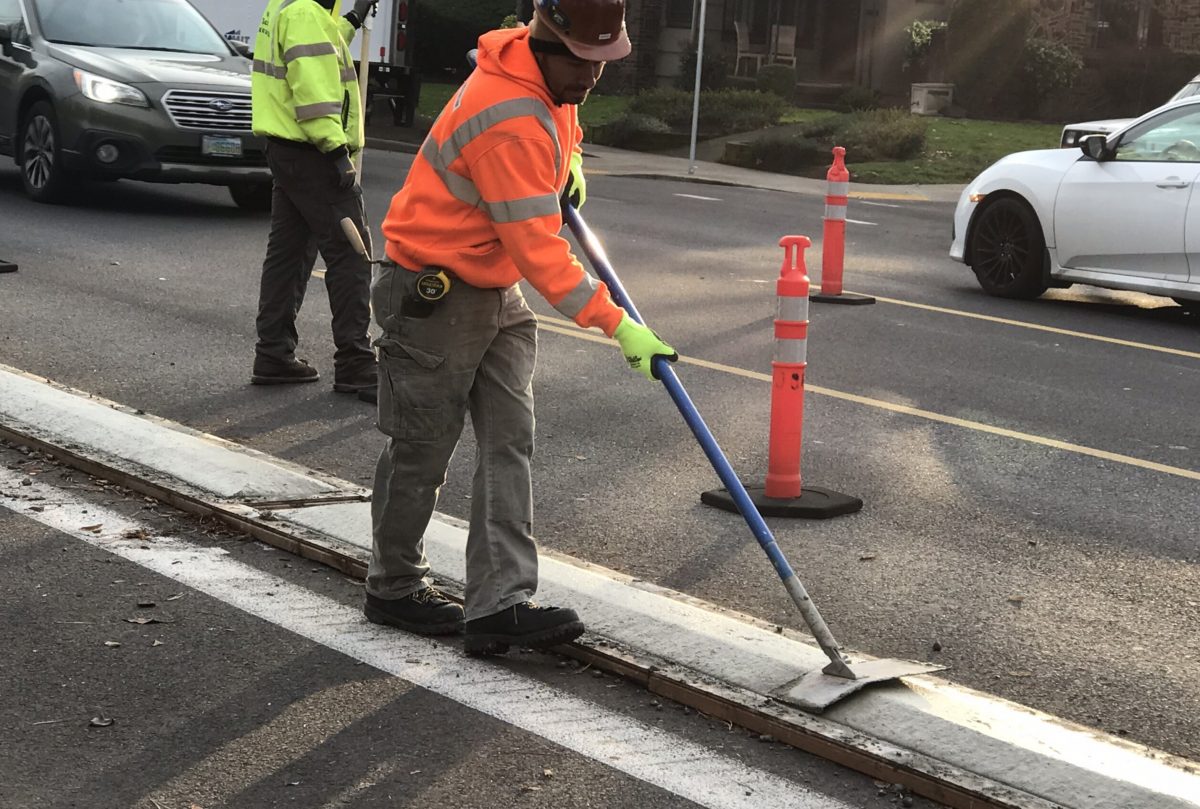
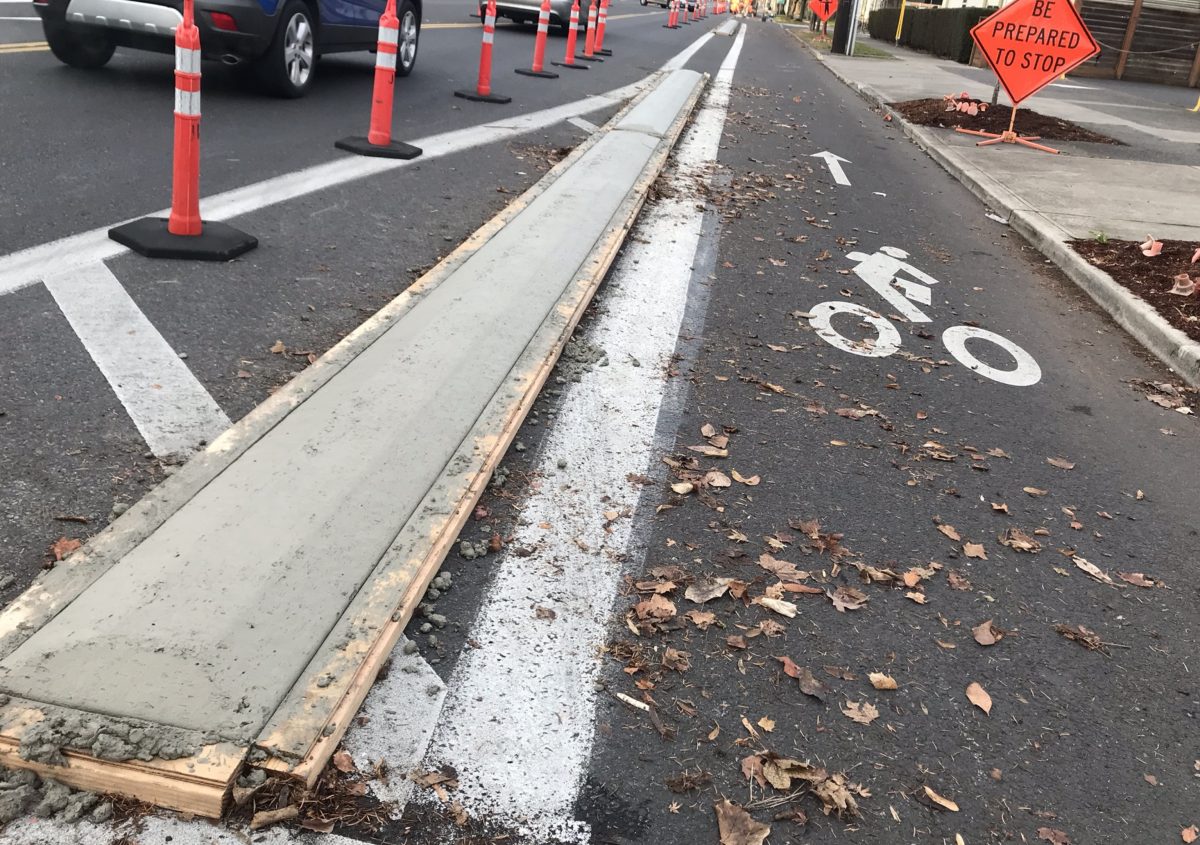
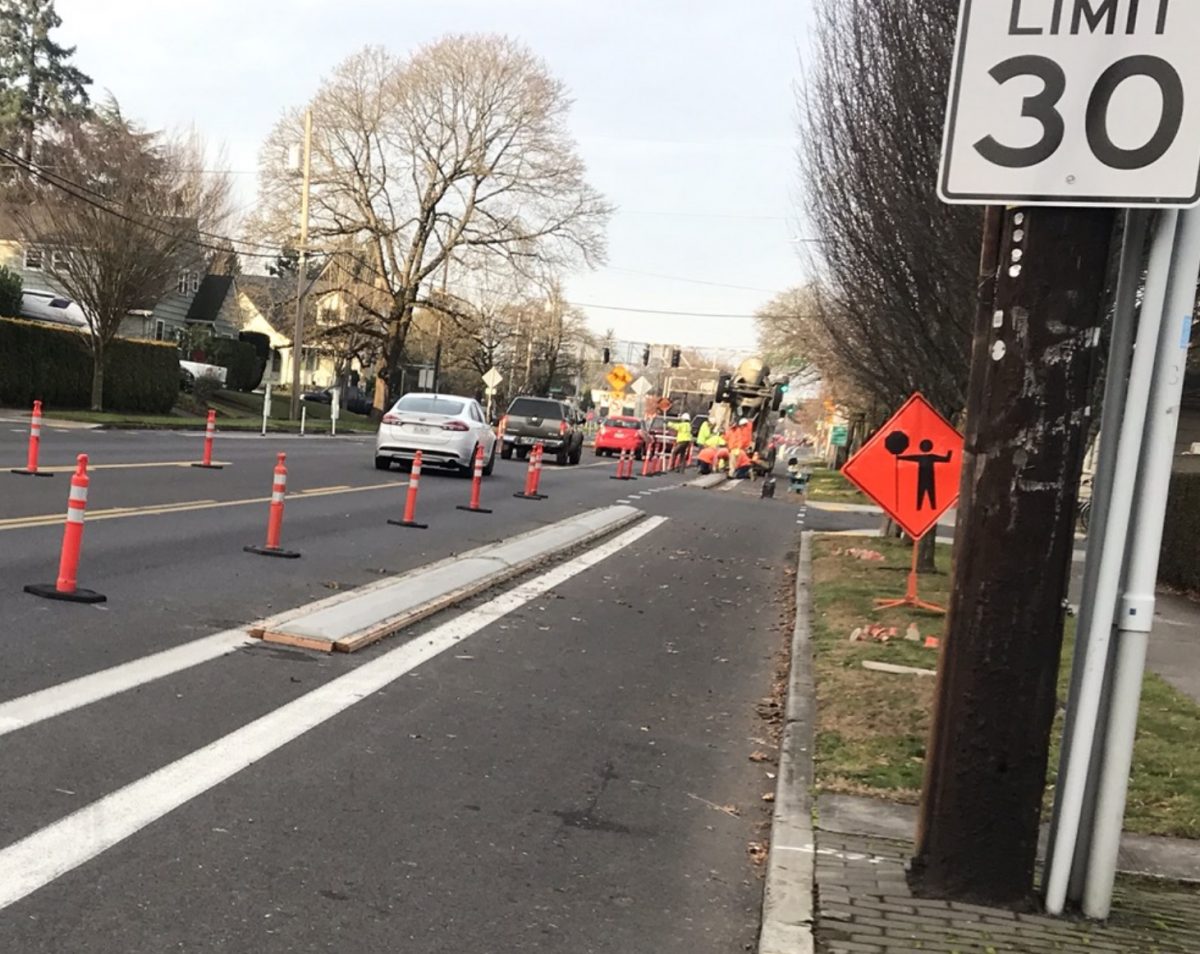
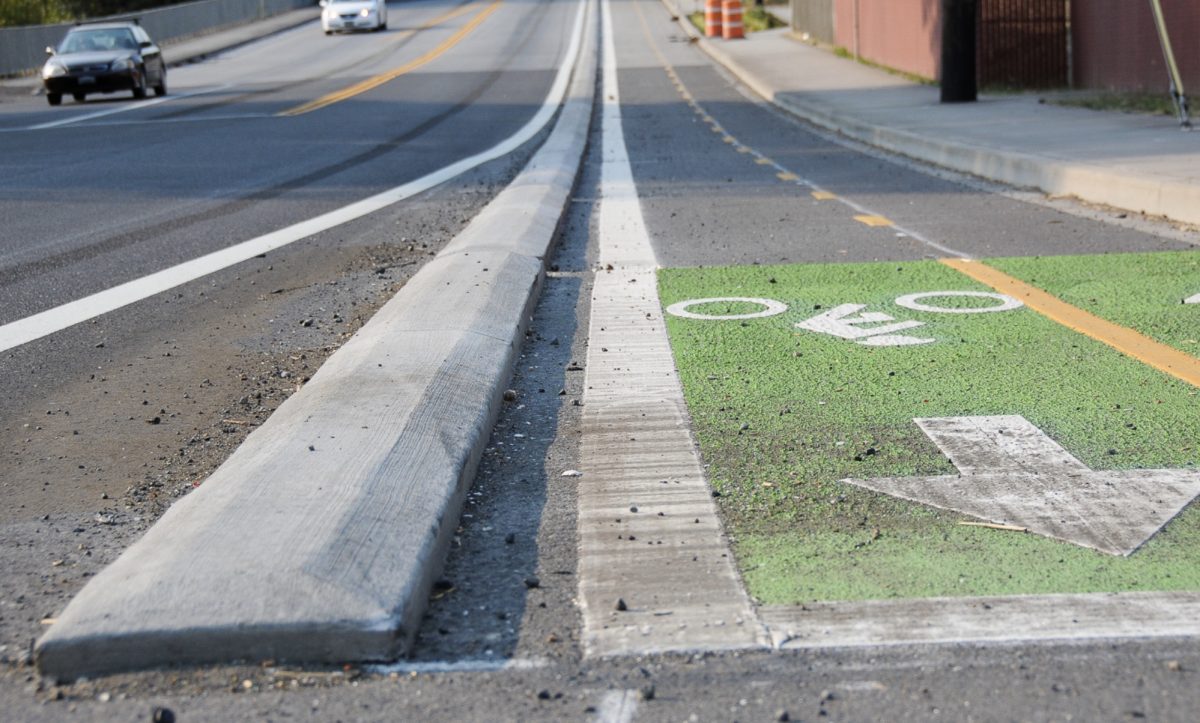
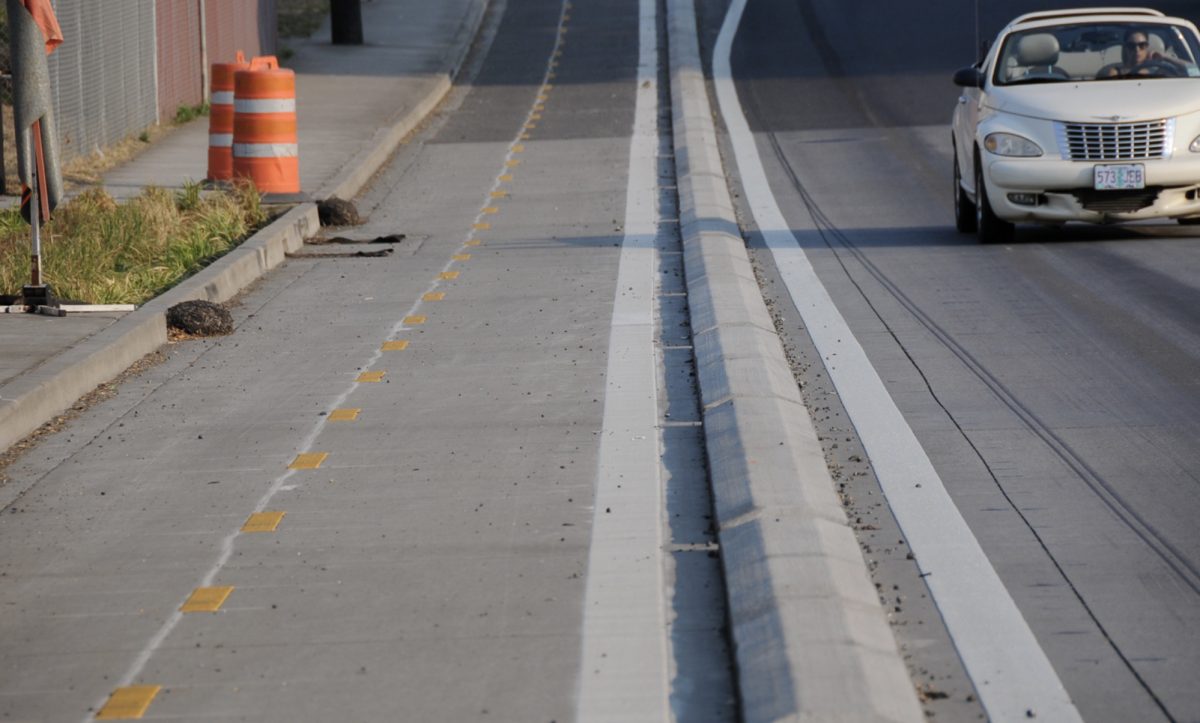
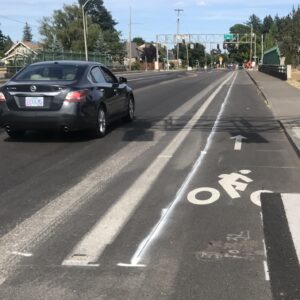
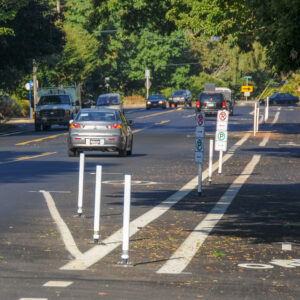
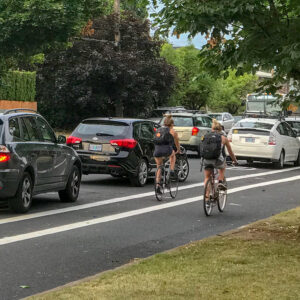
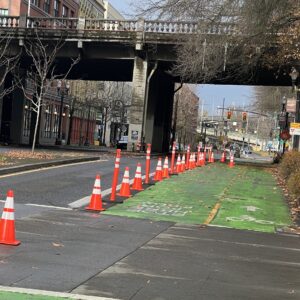
Thanks for reading.
BikePortland has served this community with independent community journalism since 2005. We rely on subscriptions from readers like you to survive. Your financial support is vital in keeping this valuable resource alive and well.
Please subscribe today to strengthen and expand our work.
Awesome! Look forward to checking them out in person. It’s a bit tangential, but I wonder about the logistics for adjacent property owners. Currently, if you want to install a new driveway, you’d get a permit and then cut the curb and pour a new acessway, meeting city requiremets for location and design, all on your dime (despite the work being on the ROW). I suppose this will be the same process, but introduces a new cost and a new dimension to the standards/approval process, making sure the curb doesn’t get hacked into non-functional pieces. I don’t think it’s a major issue, just got me thinking since I need to rebuild my driveway access.
I have been watching these being made. They are on top of the existing pavement and could be easily cut and removed if a new driveway was built.
I was wondering when you were going to post this.
Hope to see more of them – something was missing from that design…and I think this helps.
Want to add that this is bigger than the functional design of the curb and the protection it affords. By installing custom, hand-shaped (artisanal!), curbs, PBOT is sending a signal that they respect cycling. Respectable infrastructure is very important. Remember back in 2016 when I opined that if we want to be serious about cycling, we must be serious about cycling infrastructure? This is the type of thing I was thinking of. When people see high-quality work being done in the name of a particular behavior (cycling, in this case), it tells them, “We value you and we respect your choice to do this behavior.” Conversely, when PBOT builds crap bike stuff (like plastic wands that are ripped up and look like garbage strewn along the street), it sends the message that cycling is not valid and not respected.
I’m very glad to see them building these curbs and hope we see more serious, high-quality cycling infrastructure in the future.
I ride part of that section on my morning commute and saw them being installed – now that they are in place it is definitely improvement. I realize the height of them won’t stop a car but they would jolt a driver into paying attention. I think these barriers are a low cost way to get significantly better bike lanes.
Do they just pour concrete on top of the asphalt or do they need to cut the asphalt below? Just wondering from a cost perspective.
I’d love to see this replace some plastic wands on 30th and Lincoln.
They didn’t dig down. They laid rebar/wiring and forms, then came through and sculpted it in. Will be interesting to see how much of the street they finish today.
It looks like it’s built per ODOT standard detail RD706, for traffic separators on existing asphalt pavement: https://www.oregon.gov/odot/engineering/201707/RD706.pdf
They have to remove the asphalt, otherwise these would shear off when hit by a car.
could have set some rebar into the road without grinding any away.
That would also work. I’m assuming these engineers and crews are experienced and picked the most logical option to ensure these last a long time. Thin concrete is very prone to fracturing, so a small ledge like this would need a lot of rebar to last.
I wonder when that will be installed, that’s incredibly improvement to our cycle safety.
That’s an interesting idea. What if these were more ramp shaped, with the lower end on the inner/bike side? That would let a rider out of the bike lane easier, but make it harder to get back in. Wonder what the reasoning/studies are on the design of these divider curbs, or if they’re just following a generic “best practices” design for curbs with cars on both sides?
Nobody has checked in with the bunnyhop? But you don’t even need that skill, a hardtail commuter with 1.75″ road tires will pop over that curb no problem. It will also deal with those pesky trolley tracks.
Angle the front wheel into the curb (track) at about 45 and maybe hop the rear just a little so it doesn’t hook up and dump you. Practice the move over a paint line first and then try the curb thing on a Sunday morning or during the Super Bowl.
Please demo a bunny hop with a cargo bike, a tandem, or with a kid on the child seat. Thanks.
I imagine the design is related to ease of construction. The forms create the 2 inch edge, to have a smooth design would require more involvement. Infrastructure like these needs to be put up quick to reduce cost.
While it’s nice to see bike infrastructure going up, I’m not sure how I feel about this. These are obstacles to bicyclists as well. Will the bike lane get junked up with leaves and debris now? How is street sweeping going to work? All you need is a fallen over trash bin to block you in now.
I already liked that section. I guess the proof will be in riding it.
Al does make a good point here. Places where there’s dedicated, segregated roadway for bikes can be strewn with broken glass, accumulated debris etc because they’re not swept/maintained. Witness this on many of the bridges over roadways where there’s separate bike lane – even separated only by paint. Or note the separated route along Cully where debris accumulates to the point where it can be dangerous to ride. If the city adds these segregated bike routes they need to also step up and do maintenance. Sad to say but often the dreaded curb routes on streets are relatively debris free due to the “sweeping” action of passing vehicles. With this gone separated bike routes can get overwhelmed by debris.
In my experience, the city is very, very good about maintenance requests to clean up road debris, many times with a same day response time. Use the pdxreporter.org to log complaints and they should get handled promptly.
While I generally prefer posts for opportunity to bail, I think the curbs will help keep out some of that debris that gets pushed aside from vehicle lanes. Hopefully the new mini sweeper can help with leaves, etc.
That 1″ vertical section might be structurally necessary so that the concrete doesn’t just chip away. But it would be cool if they found a way to avoid it so it’s safer for bikes.
I ride this section every day and have been watching it take shape. I have a hard time seeing how a pre-formed bolt-in-place option wouldn’t be cheaper, faster to lay, and just as effective, but that can perhaps come later as the city develops their toolkit of skills and best practices.
I ran into a situation a few weeks ago as they were installing these, where a homeowner had deposited a 4ft tall pile of leaves in front of his house completely blocking the lane. It was dark and by the time I spotted it I couldn’t bail out due to the curb under construction and had to stop and hup up onto the median. I’m curious about which agency is responsible for enforcing things like the homeowner claiming the lane for… whatever- leaves, toys, garbage, etc. Blocking the lane is a rather serious problem in this design because you’re either trapped, or forced to make an unexpected split second decision to merge into the auto lane when drivers aren’t expecting it.
Despite this I’m a fan of them. They do add a sense of permanence to the lane and make you feel like you belong there just like auto traffic. Also they keep parkers out of the lane, which is an ongoing problem on yet to be curbed sections of Rosa Parks.
I’m guessing that 4′ tall pile of leaves was set up in anticipation of Leaf Day pickup on Rosa Parks. There was a pretty major lack of communication / coordination between the leaf collecting part of the city and the streets part of the city. I live on Rosa Parks and we could not get a clear answer if we were to rake our leaves into the street on the far side of the bike lane — our first choice as a cycling household — or against the curb where the sweeper would have an easier chance of picking them up. I’m assuming by next fall folks along RP will get better info about what to do.
so pumped! these, combined with pbot’s recent leaf sweeping, makes rosa parks sooooo much better to bike on! now, if they would only re-install those bollards (or somehow improve) that dangerous corner at willamette blvd.
As a multi-modal user of Rosa Parks, this looks to me like a great solution for everyone.
This is great news though I worry about when we get snow.
You can always take a regular road one block in either direction.
This is a more important point than I think some people realize. A short curb like this buried under a few inches of snow represents a hazard for both drivers and cyclists. I agree that bollards aren’t very aesthetically pleasing but there should be some reflector or something which sticks up at least a foot to alert road users of its existence as a potential obstacle.
This is how they solve this in Montreal, which sees a lot more snow than Portland does. https://goo.gl/maps/Czv8U7vXhETo3Nne7
Seems like they could add bollards on top now and they wouldn’t be ripped up and help with the delineation of the space. See how we did it in Eugene with the same kind of curbs (link below). It really helps with visibility, safety, and comfort for all users. Also, regarding concerns people have with getting out of the protected lane to access homes and businesses; spacing in the curbs allows for this kind of access and has not been an issue at all for us. Granted this is a two-way facility along a park space in this instance but we are building another two-way protected bikeway connecting the University of Oregon to Downtown this Spring/Summer and will be utilizing a similar design along a busier corridor.
Most people I talk to who have concerns about this kind of facility because they “can’t get out” or are restricted in some way (slow bikers, leaf piles, etc.) are generally people who are comfortable cyclists already. The 60% of people who are ‘interested but concerned’ NEED this kind of facility to ride in and the benefits VASTLY outweigh any perceived concerns (depending on the design of said facility, of course).
See the video about our newest protected bikeway here:
https://vimeo.com/349131750
I think the argument against wands/bollards has to do with aesthetics more than cost/function.
Oddly, people associate the ugly plastic wands with bicycles but it’s the motor vehicles that create the need. We should be blocking in motor vehicles with lots of barriers that they can’t penetrate, but their operators don’t want them.
FABULOUS!
The curb shape looks very similar to the black/yellow (plastic?) barriers that have been bolted into a few intersections near Powell’s downtown (10th & Couch) (11th and Burnside) and I noticed one also on SW 4th and Market. These are a much lower profile though and easy to drive/bike over.
I totally whacked an arm on one of the wands with a parking sign on it a couple weeks ago, this seems much better as that is a rather narrow lane.
YIPPEEEEE!!! I commute on Rosa Parks between Williams and Willamette and have struggled with cars parked or stopped on the bike lane. When I first saw these going in, I was concerned about their safety because plain concrete blends perfectly with the street. Then this morning, I noticed they’re making them orange!
Although I prefer bike lanes like the newly luxuriously wide ones on Vancouver (traditional right side placement, no parking lane), these curbs are going to make a big difference on Rosa Parks.
Interesting to see this take place, progress in spite of the ineptitude of whoever is running those contractors. They put in some bolt-down curbing and bollards at the bend where Rosa Parks bends into north Willamette.. and a day later removed half of what they’d just installed for some reason. The much-heralded bollards at the Greeley/Rosa Parks intersection have also now been removed for some reason so that autos turning right onto Greeley can cut through at speed again. I’m very happy about the bollards that were just added to impede illegal auto right turns from southbound Willamette onto the Willamette overlook (I’d started playing chicken with cars that have increasingly made that turn on my A.M. commute) but I am preemptively sad for their probable disappearance in a few days/months.
I love them. They will make taking customers out for test rides much easier! Thank you PBOT!
I am curious to find out if the barriers will lock cyclists in the bike lane when folks are getting on/off at the bus stops.
What a beautiful LIT lane!
(light individual transportation)
https://www.citylab.com/transportation/2018/08/is-it-time-to-rethink-what-a-bike-lane-is/568483/
When will something like this be done on 82nd Avenue as it veers to the right and goes downhill by Stan’s Deli. There is no safe way for employee at PDX to commute to work safely. Jersey barriers are the most protective and cost effective. The very short bike path along airport way which I call “ the bike path to nowhere” leads bike riders to a very unsafe road that parallels airport way on the north side where motor vehicles routinely drive double the speed limit with no speed enforcement by the the Airport Police department. Then cyclists have to cross the dangerous intersection at 82nd and Airport way where we are stuck between the opposite lanes on traffic on a narrow island as car drive well over the speed limit and run red lights. The Port of Portland can add a small fee to airline ticket prices as they did to pay for the light rail line on Port of Portland property to improve the bike infrastructure such a putting a pedestrian and bike bridge from the airport post office over Airport Way to protect cyclists from all of the reckless driving that occurs on Airport Way.
UPDATE: they’re not orange, they’re asphalt-colored and will be completely invisible at night. In fact, last night, a driver pulled over and drove over one to park in the bike lane right in front of me.
Also, I’m curious, where are the trash bins supposed to go? As of this morning, many of them were in the middle of the bike lane. They were empty, so this appears to be the work of the sanitation workers.
I thought about this this morning too Maria. In the past, people have put bins in the buffer zone area… which is not the curb. Will be interesting to see what happens next week when the curbs are fully installed.
The adage “something is better than nothing” is unfortunately wrong here. These little curbs are very dangerous, especially when hit by a larger tyre of an SUV. If one catches, the tyre gets pulled exactly to the right, and the whole damn SUV then hits a bike or a pedestrian. As a bike, you lose your balance, swerve, hip one of them, and then your head is in the travel lane….
Similar things happened in Bucharest on a 6 lane road from the airport. They installed these little rounded curbs to prevent head-ons due to wandering in the opposite lane by speeders, and it actually created more horrible head-ons. After a few years they ripped them all up and installed miles of jersey barriers. Education through concrete, ugly but effective….
Rolled curbs with wider separations are used throughout downtown Victoria Canada. The “inside” of the bike lane barrier is used for bike parking, streetlights and other amenities. To Google Earth it, see the intersection of Pandora Avenue at Highway 1 for an example. Vehicle traffic speeds may be lower in this context from PDX streets or highways per Joe Suburban’s post above.
While I agree that it’s too easy for a car to drive over, I don’t see the need for an emergency bail-out into the motor vehicle lane. For some reason I can’t think of any unexpected obstacles that might suddenly appear in the bike lane. All I can think of is pedestrians stumbling into it (visible hazard), cars jumping the curb (can’t bail to the left to avoid), or cars pulling out of driveways (no curb in those areas).
Yes, it’s unfair that cars get to easily jump the curb while bikes have to take more care to cross it, but I don’t think of it as a barrier to emergency maneuvers.
I think of it more like a constraint to passing, and even that isn’t a big deal because most people riding under 10 MPH will let you pass. Or you can get the jump on them at the light.
I think it’s wide enough to allow new riders space to swerve, and allow faster riders to occasionally pass. If you don’t hit your pedal on the curb while passing.
The newly striped bike lanes on SE 45th Avenue have lots of plastic wands to delineate the bike lane and keep motorists from using the bike lane to avoid waiting for left-turning motorists. It is necessary this time of year to ride in the motor vehicle lane in lots of places because residents have filled the bike lane with leaves. Admittedly, it’s not a sudden occurrence that causes one to merge with autos, but it does mean one needs to exit the bike lane for a longer interval.
Been seeing these added on my regular ride and love them! My biggest complaint is that they had a curb and wands all the way through the curve at Willamette–which was amazing– and then they just ripped it out soon after. WHY?!?